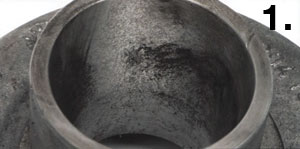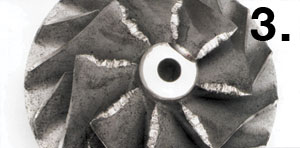MAHLE explains why compressor contamination or stress can cause issues.
Forced induction to maximize engine performance has been a growing trend for VMs for some time, but even though they’re therefore commonplace, turbochargers still represent a challenge to many independents undertaking their service or repair.
For this reason OE component and systems manufacturer MAHLE has issued technical information to highlight some of the most common causes and effects of turbocharger damage.
 Compressor-related problems
Compressor-related problems
When it comes to the air intake side of the equation, contamination of, or stress to, the compressor wheel or compressor itself will result in blue smoke (or black in the case of stress marks on the compressor wheel), excessive noise (whistling) and contamination in the charge-air cooler.
The causes can vary, but can include contamination entering the system from the crankcase vent (Fig 1), a build-up of ice or even a leak in the system from, for example, a split turbo hose.
 When it comes to the compressor wheel (Fig 2), stress is generally caused by dirty or deficient oil to the bearing, an increase in exhaust back pressure or a clogged air filter.
When it comes to the compressor wheel (Fig 2), stress is generally caused by dirty or deficient oil to the bearing, an increase in exhaust back pressure or a clogged air filter.
To remedy these situations, technicians must carefully clean the entire intake system, replace the air filter with an OE replacement, clean or renew the crankcase vent and check the system for leaks. In addition, if fitted, the air compressor’s cylinder head must be dismantled and cleaned and, following the replacement of the turbocharger and chargeair cooler, the MAF sensor must be checked.
 If the compressor wheel bearing is damaged (Fig 3), its clearance on the rotor shaft must be checked, the engine oil flushed and a new OE filter fitted with the addition of the correct grade of engine oil, as specified by the VM.
If the compressor wheel bearing is damaged (Fig 3), its clearance on the rotor shaft must be checked, the engine oil flushed and a new OE filter fitted with the addition of the correct grade of engine oil, as specified by the VM.










